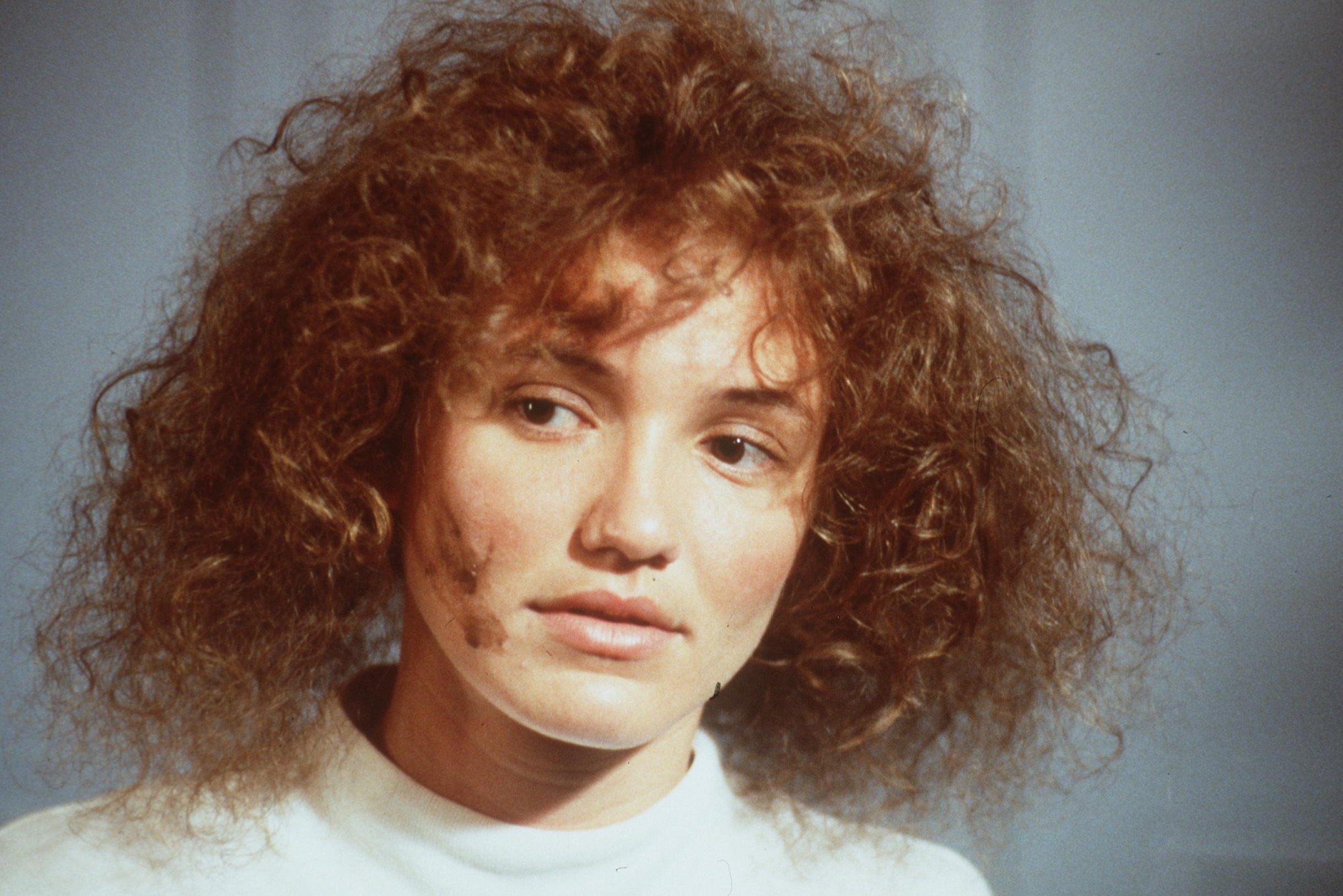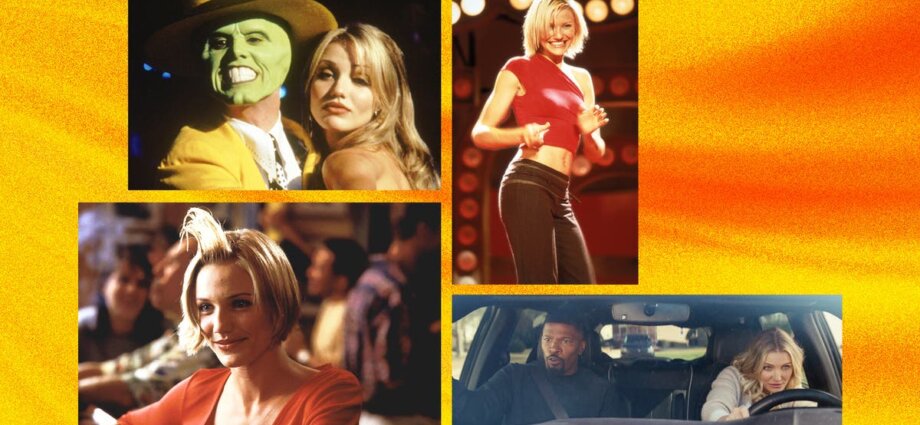The way a room full of New York film critics acted in December 1998, you’d assume Cameron Diaz had collected her shock Best Actress prize while burping and farting her way up to the podium. “More than one person present was overheard comparing this once-august event to an awards show spoof on Saturday Night Live,” The New York Observer wrote a few years later, still scandalised that thespy luminaries such as Judi Dench and Vanessa Redgrave had been beaten by a profane 26-year-old starlet – one who’d go on to win a celebrity burp-off for kids’ channel Nickelodeon. Diaz had been awarded by the city’s circle of film critics for her work in There’s Something About Mary, that year’s phenomenon of testicle gags and flying semen, and she seemed embarrassed. “Next time,” she said from the stage, “I promise to act.”
Diaz occupied this strange state of pseudo-ironic acclaim throughout her early celebrity. She was a performer propelled to stardom by her innate glow, her sprite-like sass and her sex appeal, but for whom real, earnest approval always seemed punishingly out of reach. And it was only when she retired from acting in 2015 – in an effort, she said, to “reclaim” her life – that many decided to take another look at her. Diaz made acting look like a lark, carrying with her an ease and naturalism that is typically overlooked in favour of batten-down-the-hatches histrionics. Shouldn’t we have appreciated her more as Tom Cruise’s scorned ex in Vanilla Sky, or for the sensitivity she brought to the role of a frizzy-haired, chimp-petting sadsack in Being John Malkovich? Whither her Oscar for In Her Shoes?
What luck, then, that she’s coming out of retirement, wooed by the prospect of working again with old pal Jamie Foxx in a new comedy, the aptly named Back in Action, which arrives this week. “If I was going to come back and do a movie, the only person I’d come back and do it with would be this guy,” she told Empire. The Netflix film, about married spies, is likely to be quite forgettable, a blast of low-stakes hokum with enough explosions and car chases to sustain an audience for 90 minutes in front of the box. But it is a start, the tentative first step into what could be a momentous second act. If she wants it, that is.
Diaz was always a reluctant movie star. A 21-year-old model in 1993, she only auditioned for the Jim Carrey vehicle The Mask at the behest of her agent. Acting wasn’t on the cards, or even an interest, but Diaz won the part of the film’s female lead, a sultry nightclub singer who tangles with Carrey’s green-faced chaos agent. “Cameron Diaz is a true discovery in the film, a genuine sex bomb with a gorgeous face, a wonderful smile, and a gift of comic timing,” wrote film critic Roger Ebert upon its release. “This is her first movie role, after a brief modelling career. It will not be her last.” Ebert’s comments spoke to what a juggernaut she is in that film, a stop-you-in-your-tracks dreamgirl whom Carrey seems completely enraptured by. Same, Jim, same.
Pronounced Hollywood’s next big thing, Diaz quickly subverted expectations by going small (injuring her wrist on the set of what would have been her follow-up movie, the expensive video-game adaptation Mortal Kombat, was the second in a series of lucky breaks). She used indies such as 1995’s dark comedy The Last Supper as acting boot camps, honing her craft. But she was also resistant to proper movie stardom. “I don’t ever want my name to be the first over the title,” she said in 1997. And that’s why she gravitated towards ensembles: Danny Boyle’s scatterbrained Trainspotting follow-up A Life Less Ordinary; the starry romantic drama She’s the One; girl-gang comedies including Charlie’s Angels and The Sweetest Thing.
The magic of early Cameron Diaz is in how dazzling she is, how much you’d absolutely follow her to the ends of the earth if she asked you to. There’s Something About Mary only works because of Diaz’s believability as a woman every man falls in love with on sight. And My Best Friend’s Wedding, released a year earlier in 1997, is one of that era’s smartest romantic comedies because it so successfully leans into Diaz’s star power. She is introduced as the wealthy love rival to Julia Roberts’s big-city food critic, a dippy other woman who’s “stolen” the guy Roberts is surely meant to end up with. But Diaz is so endearing, and Roberts so fascinatingly devious, that the movie takes a sharp-left turn at its midpoint. Roberts, our ostensible everywoman, becomes My Best Friend’s Wedding’s villain, Diaz its misunderstood hero.

Around this point in Diaz’s stardom, her films became a tonal grab-bag of varying quality. She’s brilliantly scary in Vanilla Sky, lovely and vulnerable as a blind woman in the tiny ensemble drama Things You Can Tell Just by Looking at Her, but also wildly miscast as a tough-talking business executive in Oliver Stone’s American football movie Any Given Sunday, and as an Irish pickpocket in Martin Scorsese’s Gangs of New York. Annoyingly, those last two films – big, sprawling epics by powerhouse directors – were painted in the press as Diaz’s “real” movies, the ones designed to lift her out of the gross-out comedy space that she’d never actually complained about. The criticism misread her interests, and the kind of actor she was.
But effervescence can’t be taught. Diaz’s power has always been her extraordinary ordinary-ness, her lack of frills and Hollywood nonsense. “What really makes her unique is this charm she’s got, and humour she’s got, that makes her appealing to both men and women,” said Chuck Russell, her director on The Mask. She’s no super-woman in Mary or 2006’s festive perennial The Holiday, just a regular girl looking for love and happiness – us, basically, if a little shinier. “There’s always laughter around Cameron,” her director on The Holiday, Nancy Meyers, once said, while comparing her to a kind of “human antidepressant” on set. She seemed to know this about herself. In a Vanity Fair profile in 2002 headlined “The Frat House Goddess”, designed to promote her work in Gangs of New York, Diaz expressed her lack of interest in the business side of moviemaking. On the set of the Charlie’s Angels sequel, she recalled, “Lucy [Liu] is on her fricking BlackBerry like every second … Drew [Barrymore]’s making phone calls, and I’m just like, ‘You guys need me on the set? No? Good. I’m just going to mosey on back to my trailer and whip up a little something to eat. Anybody hungry?’” Speaking to the same magazine two years later, she said she most admires Michelle Pfeiffer: “She works eight-hour days, and only during the summer.”

It’s no wonder she eventually walked away. Particularly when so many of her later movies seemed phoned in from top to bottom: the Ashton Kutcher romcom What Happens in Vegas (2008), the Seth Rogen superhero film The Green Hornet (2011), whatever the Annie remake (2014) was. Ridley Scott’s gonzo pulp thriller The Counsellor (2013) – in which Diaz races cheetahs and has sex with a car windshield – and Richard Kelly’s trippy thought-experiment horror film The Box (2009) are, in my book, secret gems, but about six people saw them. If the work has become work, the films you’re most proud of are vanishing, and you’re hardly in need of cash, why wouldn’t you pack it all in?

Watch Apple TV+ free for 7 days
New subscribers only. £8.99/mo. after free trial. Plan auto-renews until cancelled
Back in Action, a globetrotting espionage film, seems like a “Sure, why not?” choice for Diaz – a chance to jet around the world on Netflix’s dime, and to work with an actor she likes. She’s also declined to say whether she’s back for good (though she has a Keanu Reeves black comedy called Outcome on the horizon, and an apparent Shrek 5). “I reserve the right to say no to doing a movie ever again, and I reserve the right to say yes if I decide to,” she told Empire. But much of Diaz’s career has been dictated in the same way: gut-instinct choices, favours for friends, films that just seem like fun things to do.
The only difference is that this time we have a chance to really appreciate her in the moment, and not with an ironic wink or a hint of cynicism. Cameron Diaz: Most Regular Superstar. May she forever belch and pratfall.
‘Back in Action’ streams on Netflix from 17 January











